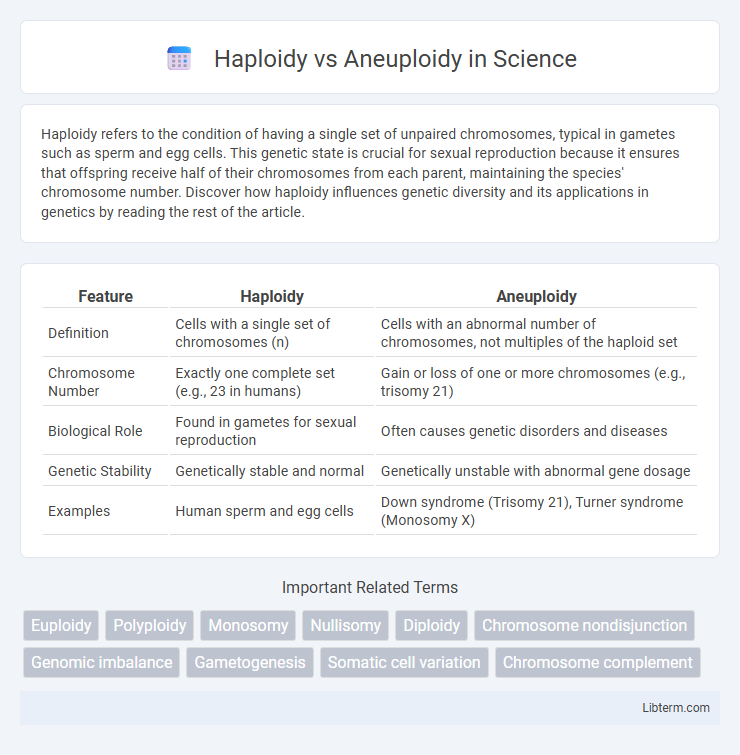Haploidy refers to the condition of having a single set of unpaired chromosomes, typical in gametes such as sperm and egg cells. This genetic state is crucial for sexual reproduction because it ensures that offspring receive half of their chromosomes from each parent, maintaining the species' chromosome number. Discover how haploidy influences genetic diversity and its applications in genetics by reading the rest of the article.
Table of Comparison
| Feature | Haploidy | Aneuploidy |
|---|---|---|
| Definition | Cells with a single set of chromosomes (n) | Cells with an abnormal number of chromosomes, not multiples of the haploid set |
| Chromosome Number | Exactly one complete set (e.g., 23 in humans) | Gain or loss of one or more chromosomes (e.g., trisomy 21) |
| Biological Role | Found in gametes for sexual reproduction | Often causes genetic disorders and diseases |
| Genetic Stability | Genetically stable and normal | Genetically unstable with abnormal gene dosage |
| Examples | Human sperm and egg cells | Down syndrome (Trisomy 21), Turner syndrome (Monosomy X) |
Introduction to Chromosomal Variations
Chromosomal variations include haploidy, the presence of a single set of chromosomes, and aneuploidy, characterized by an abnormal number of chromosomes. Haploidy is commonly observed in gametes, facilitating sexual reproduction, while aneuploidy results from nondisjunction events causing whole chromosome gains or losses. These variations significantly impact genetic stability, development, and can lead to disorders such as Down syndrome or Turner syndrome.
Defining Haploidy
Haploidy refers to a cellular state in which a cell contains a single complete set of chromosomes, denoted as n, typical in gametes such as sperm and egg cells. This contrasts with aneuploidy, which involves an abnormal number of chromosomes that is not a complete set, often causing genetic disorders like Down syndrome. Haploid cells are essential for sexual reproduction, ensuring that offspring inherit a diploid chromosome complement after fertilization.
Understanding Aneuploidy
Aneuploidy refers to the presence of an abnormal number of chromosomes in a cell, typically resulting from nondisjunction during meiosis or mitosis, leading to disorders such as Down syndrome, Klinefelter syndrome, or Turner syndrome. Unlike haploidy, where cells contain a single set of chromosomes (n), aneuploidy involves an extra or missing chromosome, disrupting normal gene dosage and cellular function. Understanding aneuploidy is crucial for diagnosing genetic diseases, studying cancer progression, and developing targeted therapies.
Key Differences Between Haploidy and Aneuploidy
Haploidy refers to a cell or organism having a single set of chromosomes (n), typical in gametes, whereas aneuploidy involves an abnormal number of chromosomes, either missing or extra, deviating from the diploid number. Haploidy results from a normal reduction division during meiosis, while aneuploidy arises due to nondisjunction or chromosome missegregation during cell division. The key difference lies in haploidy representing a complete chromosome set, whereas aneuploidy represents a partial deviation from the standard chromosome count, often leading to genetic disorders or developmental abnormalities.
Mechanisms Behind Haploidy Formation
Haploidy formation primarily occurs through mechanisms such as genome elimination, where one parental set of chromosomes is selectively lost during early embryonic development, and uniparental chromosome inheritance due to errors in meiosis or fertilization. In plants, haploids can arise via androgenesis or gynogenesis, processes involving the development of embryos from male or female gametes without fertilization. Understanding these mechanisms provides crucial insights for applications in breeding programs and genetic research.
Causes of Aneuploidy in Cells
Aneuploidy in cells primarily arises from errors during cell division, specifically nondisjunction events during meiosis or mitosis, leading to an abnormal number of chromosomes. Causes include spindle assembly checkpoint failure, impaired chromosome segregation, and defective kinetochore-microtubule attachments. Environmental factors such as radiation and chemical exposure can further increase the likelihood of aneuploidy by damaging the cellular machinery involved in accurate chromosome distribution.
Biological Significance of Haploidy
Haploidy, the condition of having a single set of chromosomes, plays a crucial biological role in sexual reproduction by enabling genetic diversity through meiosis and fertilization. It ensures the maintenance of chromosome number across generations and facilitates the elimination of deleterious mutations. Unlike aneuploidy, which results from an abnormal number of chromosomes leading to genetic disorders, haploidy serves as a stable and essential phase in the life cycle of many organisms.
Clinical Implications of Aneuploidy
Aneuploidy, characterized by an abnormal number of chromosomes, is associated with various clinical conditions including Down syndrome (trisomy 21), Turner syndrome (monosomy X), and cancers like leukemia where chromosomal imbalances drive tumor progression. Unlike haploidy, which involves a single set of chromosomes and is typically incompatible with human viability except in gametes, aneuploidy often leads to developmental disorders, infertility, and increased risk of miscarriage. Clinical detection of aneuploidy through techniques like karyotyping and non-invasive prenatal testing enables early diagnosis and informed medical management.
Examples of Haploidy and Aneuploidy in Nature
Haploidy is commonly observed in organisms like male bees, ants, and wasps, where haploid males develop from unfertilized eggs through a process called parthenogenesis. Aneuploidy occurs frequently in humans, with Down syndrome caused by trisomy 21 being a well-known example, involving an extra copy of chromosome 21. In plants, aneuploidy can result in variations such as monosomy or trisomy, often leading to developmental abnormalities or altered traits.
Conclusion: The Impact of Chromosomal Variation
Chromosomal variations such as haploidy and aneuploidy significantly influence genetic stability and organismal development. Haploidy, characterized by a single set of chromosomes, often results in reduced genetic diversity but can be advantageous for specific biological processes like gamete formation. Aneuploidy, involving abnormal chromosome numbers, typically disrupts cellular function and is linked to developmental disorders and diseases, highlighting its critical impact on health and evolution.
Haploidy Infographic

 libterm.com
libterm.com